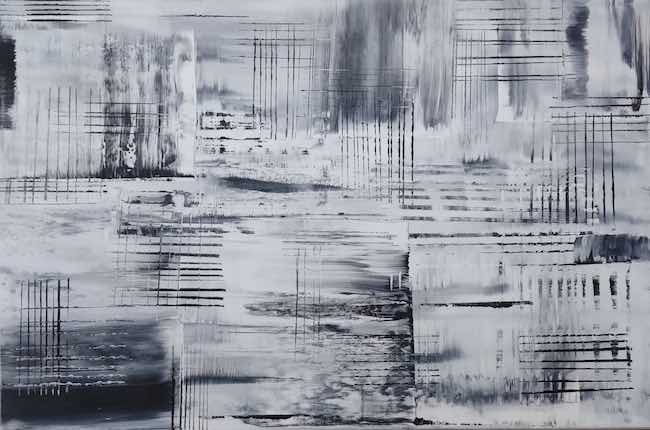Raccontare tutto ciò che appartiene al mondo interiore senza doversi attenere a regole espressive accademiche è l’imperativo di un considerevole gruppo di creativi che desiderano lasciar fuoriuscire in maniera impulsiva e spontanea le sensazioni che percepiscono dall’esterno e che costituiscono uno spunto di riflessione e di analisi non solo di ciò che circonda l’individuo ma anche della sua reazione agli accadimenti i quali inevitabilmente poi spingono per essere comunicati. La modalità esecutiva deve essere tanto libera quanto personale perché in fondo costituisce un’interpretazione delle circostanze sulla base della singola sensibilità, di conseguenza l’autonomia espressiva e l’indefinitezza delle immagini costituiscono un mezzo indispensabile per lasciar fluire un universo interiore troppo complesso per essere rappresentato da una raffigurazione più definita. L’artista di cui vi racconterò oggi ha scelto esattamente questa strada per imprimere sulla tela le sue sensazioni.
Il mondo delle emozioni è stato lungamente messo a tacere in larga parte dell’Arte Astratta della prima metà del Novecento per dare maggiore risalto alla purezza dell’atto plastico, al suo valore indipendente da ogni soggettivismo dell’esecutore dell’opera, e concentrando l’attenzione su un approccio più analitico, più scientifico o intellettuale al gesto creativo. Da un lato c’erano i movimenti deterministi e distaccati da tutto ciò che potesse influenzare la realizzazione di un dipinto, come il De Stijl, l’Astrattismo Geometrico, lo Spazialismo, il Minimalismo, dall’altro invece c’erano le linee guida iniziali del fondatore dell’Astrattismo, Vassily Kandinsky, che non ripudiava il legame con il mondo interiore anzi, ne esaltava la necessità di connessione con l’atto di creazione di un’opera. Il contesto storico, le guerre che si erano susseguite e le atrocità a cui molti artisti avevano assistito, costretti spesso, quando riuscivano, a rifugiarsi negli Stati Uniti per trovare una speranza di vita, determinarono però un’inversione di tendenza poiché tutto quel mondo interiore tormentato e spesso spaventato a causa delle esperienze vissute, aveva bisogno di gridare, di trovare una valvola di sfogo attraverso uno stile che non avesse le catene costituite dalle regole della figurazione e al tempo stesso concedesse agli artisti di poter imprimere sulla tela la propria interiorità. Fu così che poco prima degli anni Cinquanta del Novecento, Jackson Pollock, Mark Rothko, Franz Kline, Willem De Koonig, Barnett Newmann e Adolf Gottlieb diedero vita a un movimento artistico rivoluzionario e destinato a cambiare per sempre il corso della storia dell’arte; il gruppo prese il nome di Espressionismo Astratto e dovette combattere contro le opposizioni degli ambienti culturali e istituzionali dell’epoca nel considerarlo all’altezza delle altre avanguardie ma poi la determinazione dei suoi esponenti vinse, così come il pubblico e i grandi collezionisti si lasciarono conquistare da quel mondo fatto di pura emozione in grado di toccare le corde profonde dell’osservatore. L’artista statunitense Shannon Dearth dopo ventisette anni di servizio nell’esercito del suo paese, rientra in Oregon e sente quasi subito l’esigenza di aprirsi al contatto con le sensazioni accumulate e taciute quando era arruolato, decidendo pertanto di prendere in mano i pennelli e cominciare a dialogare in maniera spontanea e immediata con la tela che si poteva trasformare in mezzo interpretativo di un’interiorità messa necessariamente in silenzio per impostazione professionale ma che poi non riusciva più a rimanere nascosta.
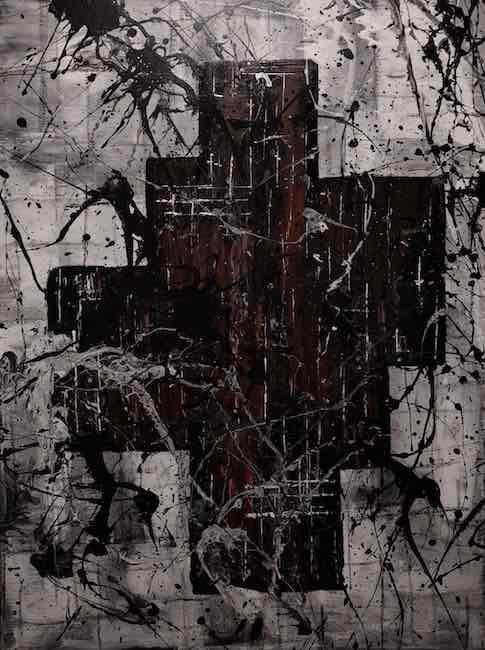
L’Espressionismo Astratto è lo stile che lo contraddistingue perché in fondo il più affine a donargli quel senso di libertà per lui indispensabile a permettere alle sue profondità di emergere, di trovare un canale per affiorare alla consapevolezza e poi a essere narrate e che riceve dall’attenta osservazione di tutto ciò che ruota intorno a sé, al suo quotidiano, quei frammenti di emozioni che spesso vengono trascurate o dimenticate nel rumore del vivere o nella fretta di raggiungere obiettivi più materiali e che invece Dearth ascolta, recepisce, medita e poi trasforma in forme evocative attraverso le quali coinvolge l’osservatore nel suo sentire.
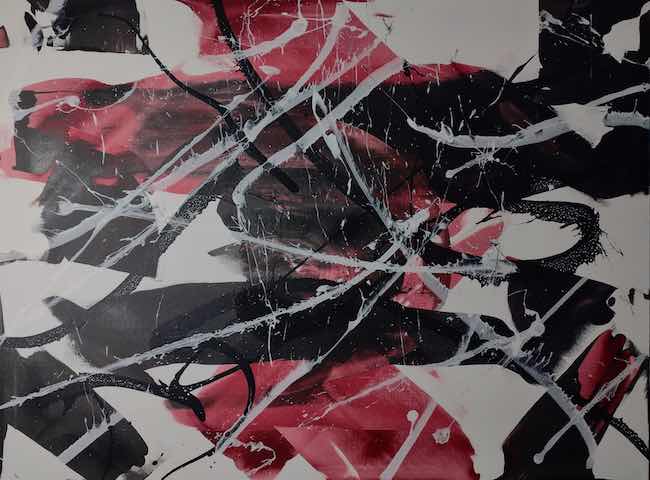
A volte più schematico e minimalista, altre più teso verso una figurazione suggestiva e quasi metafisica, altre invece decisamente più indefinito, il suo tocco pittorico si asseconda a ciò che la sua interiorità ha bisogno di comunicare, sottolineando quanto per lui sia essenziale rinunciare a ogni norma, a ogni principio esecutivo che lo priverebbe della spontaneità esplorativa di cui ha bisogno per approfondire la conoscenza di se stesso e della realtà intorno a lui.
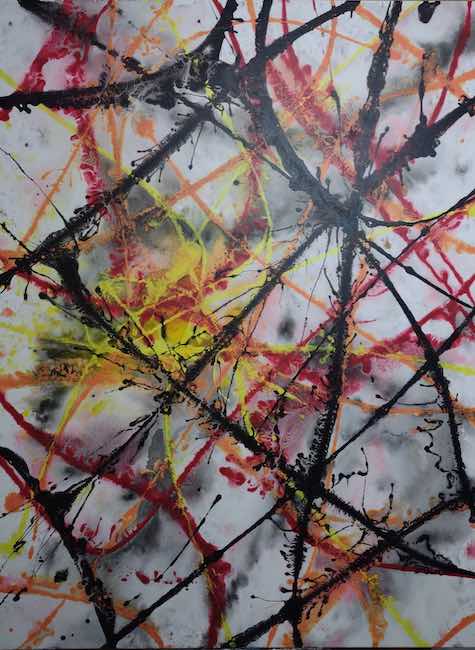
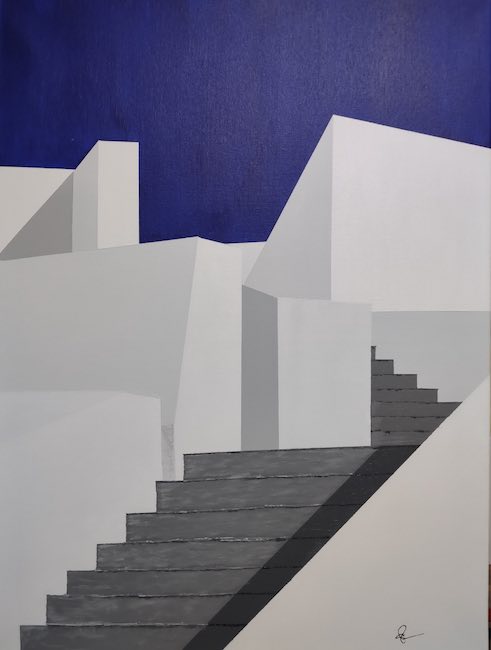
Alcune opere appaiono dunque più riflessive, più orientate a percepire le sottili vibrazioni che fuoriescono da un paesaggio, da uno scorcio che si trasforma in frammento di memoria, sintomo di una sensazione avvolgente vissuta da Shannon Dearth quando si è trovato davanti al panorama immortalato e poi metabolizzata nel suo senso più profondo, in virtù di tutto ciò che ha contribuito a rendere quel ricordo qualcosa di speciale; l’opera Santorini è fortemente stilizzata, ridotta all’essenziale di ciò che contraddistingue la meravigliosa isola greca, il bianco delle case e l’azzurro intenso del cielo, e malgrado la composizione sia priva di dettagli se non i tipici gradini che sembrano finire nel cielo stesso, l’immaginazione non può fare a meno di correre ai profumi e alla bellezza di quel luogo incantato incastonato nel mar Egeo.
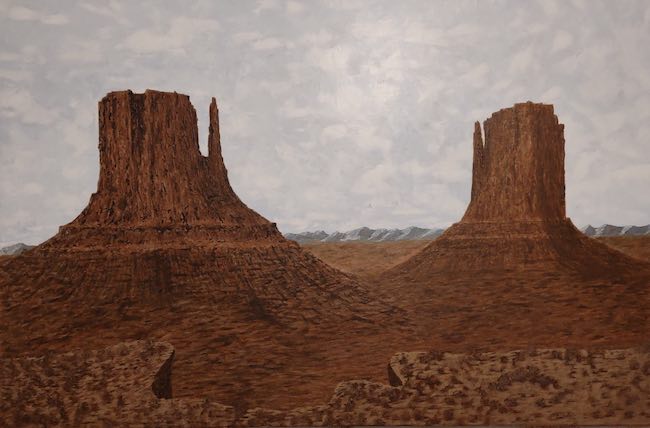
E ancora, in Guardians of the plateau (I guardiani dell’altopiano) l’artista descrive uno dei paesaggi più tipici delle steppe statunitensi in cui spesso formazioni rocciose svettano su sterminate pianure, quasi a voler dominare la scena, controllando e proteggendo tutto ciò che ne fa parte; in qualche modo sembra avvicinarsi al concetto delle tribù indiane americane in cui gli oggetti inanimati della natura avevano un’anima e costituivano un importante punto di riferimento per l’essere umano che sceglieva di porsi in posizione di ascolto, di contatto con la natura incontaminata. L’atmosfera appare rarefatta, come se quello scorcio di paesaggio fosse funzionale a Dearth a cercare le sue origini, a dialogare con un’interiorità che riesce a trovare il proprio equilibrio in virtù del silenzio che circonda le formazioni rocciose e dell’assenza di riferimenti visivi che possano distrarre dall’approfondimento. Quando però affonda nelle sue emozioni l’artista ha bisogno di spostarsi verso l’indefinitezza totale, la non forma dentro cui è più facile dare libero sfogo a tutto ciò che riceve dall’esterno, alle sensazioni legate a un pensiero fugace, all’umore di un attimo in grado di determinare il senso di un intero giorno, di modificare o sovvertire un concetto grazie alla capacità di connettersi con la propria sensibilità.
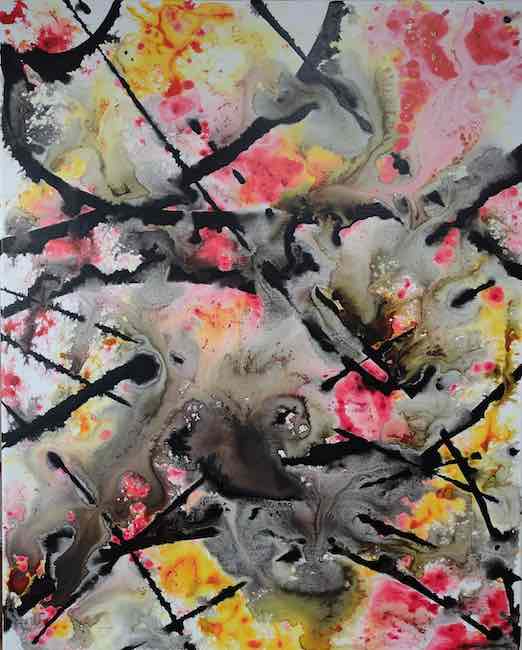
Il dipinto Mystique (Mistico) racconta con toni delicati un viaggio attraverso la spiritualità, dentro quell’universo complesso e intricato e spesso inconosciuto in cui l’essere umano contemporaneo dovrebbe essere capace di addentrarsi più frequentemente, per non perdere il contatto con quelle fuggevoli sensazioni che se colte hanno il potere di modificare l’intero quadro della realtà; è proprio quell’approccio, quella capacità di andare oltre il visibile, sembra suggerire Shannon Dearth, che consentono all’uomo moderno di rimanere umano, di mantenere la fiducia che qualcosa di bello possa sempre accadere, malgrado la contingenza sembri indicare il contrario.
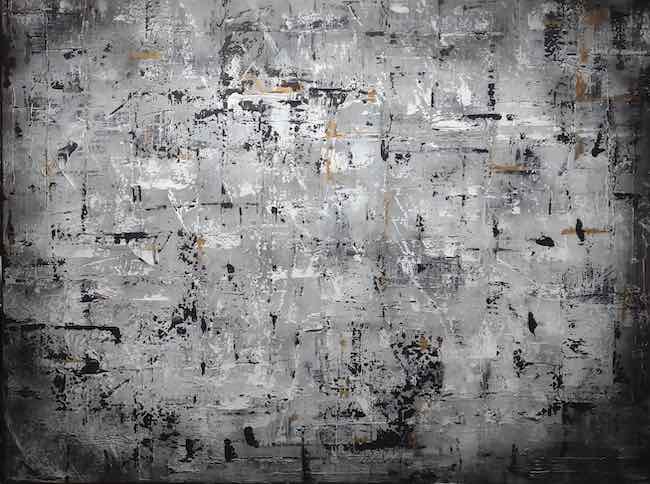
Le opere più visionarie invece, quelle in cui l’artista affronta concetti più astratti, più orientati a spiegare l’inspiegabile o a dare un’interpretazione simbolica a quelle metafore che appartengono da sempre all’immaginario comune e che spesso restano però tanto irrisolti quanto ripetitivi ne siano i concetti che desiderano esprimere, si spingono verso un’indefinitezza e una nebulosità maggiori. Lo stile pittorico si fa più dissolvente, meno netto, più orientato a utilizzare la scala di grigi perché in fondo è proprio attraverso l’astrazione più pura, minimizzata, che la mente riesce a lasciare da parte la logica e a spingersi verso un approfondimento più emozionale. Le opere di Shannon Dearth sono un ponte tra interiorità ed esteriorità, tra ciò che lui intuisce e assorbe e il mondo esterno, senza il quale le emozioni non si consoliderebbero fino a raggiungere la consapevolezza.
SHANNON DEARTH-CONTATTI
Email: deartht@msn.com
Sito web: https://fineartamerica.com/profiles/shannon-dearth
Facebook: https://www.facebook.com/shannon.dearth
Instagram: https://www.instagram.com/abstraxtbyshannon/
Linkedin: https://www.linkedin.com/in/shannon-b-dearth-39957440/
The deep voice of the emotions in Abstract Expressionism by Shannon Dearth
Telling everything that belongs to the inner world without having to adhere to academic rules of expression is the imperative of a considerable group of creatives who wish to let out in an impulsive and spontaneous manner the feelings that they perceive from the outside and that constitute a cue for reflection and analysis not only of what surrounds the individual but also of his reaction to the events that inevitably then push to be communicated. The method of execution must be as free as it is personal, because after all, it constitutes an interpretation of circumstances on the basis of individual sensibility. Consequently, the expressive autonomy and indefiniteness of the images constitute an indispensable means of letting flow an inner universe that is too complex to be represented by a more defined depiction. The artist I am going to tell you about today has chosen exactly this path to imprint his feelings on canvas.
The world of emotions was silenced for a long time in much of the Abstract Art of the first half of the 20th century in order to give greater prominence to the purity of the plastic act, to its value independent of any subjectivism of the executor of the artwork, and to focus attention on a more analytical, more scientific or intellectual approach to the creative gesture. On the one hand there were the determinist movements, detached from anything that could influence the creation of a painting, such as De Stijl, Geometric Abstractionism, Spatialism, Minimalism, on the other hand there were the initial guidelines of the founder of Abstractionism, Vassily Kandinsky, who did not repudiate the link with the inner world, on the contrary, he extolled the need for connection with the act of creating an artwork. However, the historical context, the wars that followed and the atrocities that many artists had witnessed, often forced, when they succeeded, to take refuge in the United States to find a hope of life, brought about a reversal of the trend, since all that inner world, tormented and often frightened by the experiences they had lived through, needed to cry out, to find an outlet through a style that did not have the shackles of the rules of figuration and at the same time allowed artists to imprint their inner selves on canvas.
So it was that shortly before the 1950s, Jackson Pollock, Mark Rothko, Franz Kline, Willem De Koonig, Barnett Newmann and Adolf Gottlieb gave birth to a revolutionary artistic movement that was destined to change the course of art history forever; The group took the name of Abstract Expressionism and had to fight against the opposition of the cultural and institutional circles of the time in considering it equal to the other avant-gardes, but then the determination of its exponents won out, just as the public and the great collectors allowed themselves to be won over by that world of pure emotion capable of touching the deepest chords of the observer. The American artist Shannon Dearth, after twenty-seven years of service in his country’s army, returned to Oregon and almost immediately felt the need to open himself up to contact with the sensations accumulated and concealed when he was enlisted. He therefore decided to pick up his paintbrushes and begin a spontaneous and immediate dialogue with the canvas that could be transformed into an interpretative medium of an interiority which was necessarily silenced by professional settings but could no longer remain hidden. Abstract Expressionism is the style that distinguishes him because it is, after all, the one most akin to giving him that sense of freedom that is indispensable for him to allow his depths to emerge, to find a channel to surface to awareness and then to be narrated, and that he receives from careful observation of everything that revolves around him, his daily life, those fragments of emotions that are often overlooked or forgotten in the noise of living or in the haste to achieve more material goals, and that Dearth instead listens to, takes in, meditates on and then transforms into evocative forms through which he involves the observer in his feeling.
At times more schematic and minimalist, at others more tending towards an evocative and almost metaphysical figuration, and at others decidedly more indefinite, his pictorial touch goes along with what his interiority needs to communicate, emphasising how essential it is for him to renounce all rules, all executive principles that would deprive him of the exploratory spontaneity he needs to deepen his knowledge of himself and the reality around him. Some artworks therefore appear more reflective, more oriented towards perceiving the subtle vibrations which emanate from a landscape, from a glimpse that becomes a fragment of memory, a symptom of an enveloping sensation experienced by Shannon Dearth when he found himself in front of the immortalised panorama and then metabolised in its deepest sense, by virtue of everything that contributed to making that memory something special; the painting Santorini is highly stylised, reduced to the essentials of what characterises the marvellous Greek island, the white of the houses and the intense blue of the sky, and although the composition is devoid of detail except for the typical steps that seem to end in the sky itself, the imagination cannot help but run to the scents and beauty of that enchanted place set in the Aegean Sea. And again, in Guardians of the plateau the artist describes one of the most typical landscapes of the American steppes in which rock formations often tower over endless plains, almost as if they wanted to dominate the scene, controlling and protecting everything that is part of it; in some ways he seems to come close to the concept of the American Indian tribes in which inanimate objects of nature had a soul and constituted an important point of reference for the human being who chose to place himself in a position of listening, of contact with uncontaminated nature. The atmosphere appears rarefied, as if that glimpse of landscape was a function for Dearth to search for his origins, to dialogue with an interiority that manages to find its own equilibrium by virtue of the silence surrounding the rock formations and the absence of visual references that could distract from the exploration. However, when he sinks into his emotions, the artist needs to move towards total indefiniteness, the non-form within which it is easier to give free rein to everything he receives from the outside, to the sensations linked to a fleeting thought, to the mood of a moment that can determine the meaning of an entire day, to modify or subvert a concept thanks to his ability to connect with his own sensitivity.
The painting Mystique recounts in delicate tones a journey through spirituality, into that complex, intricate and often unrecognised universe into which the contemporary human being should be able to delve more frequently, so as not to lose contact with those fleeting sensations that if grasped have the power to change the entire picture of reality; it is precisely that approach, that ability to go beyond the visible, seems to suggest Shannon Dearth, that allows modern man to remain human, to maintain the faith that something beautiful can always happen, despite contingency seeming to indicate otherwise. The more visionary paintings, on the other hand, those in which the artist deals with more abstract concepts, more oriented towards explaining the inexplicable or giving a symbolic interpretation to those metaphors that have always belonged to the common imagination and yet often remain as unsolved as the concepts they wish to express are repetitive, move towards greater indefiniteness and vagueness. The pictorial style becomes more dissolving, less sharp, more oriented towards the use of greyscale because after all, it is precisely through the purest, minimised abstraction that the mind is able to leave logic aside and move towards a more emotional deepening. Shannon Dearth’s artworks are a bridge between interiority and exteriority, between what he intuits and absorbs and the external world, without which emotions would not be consolidated to the point of awareness.


